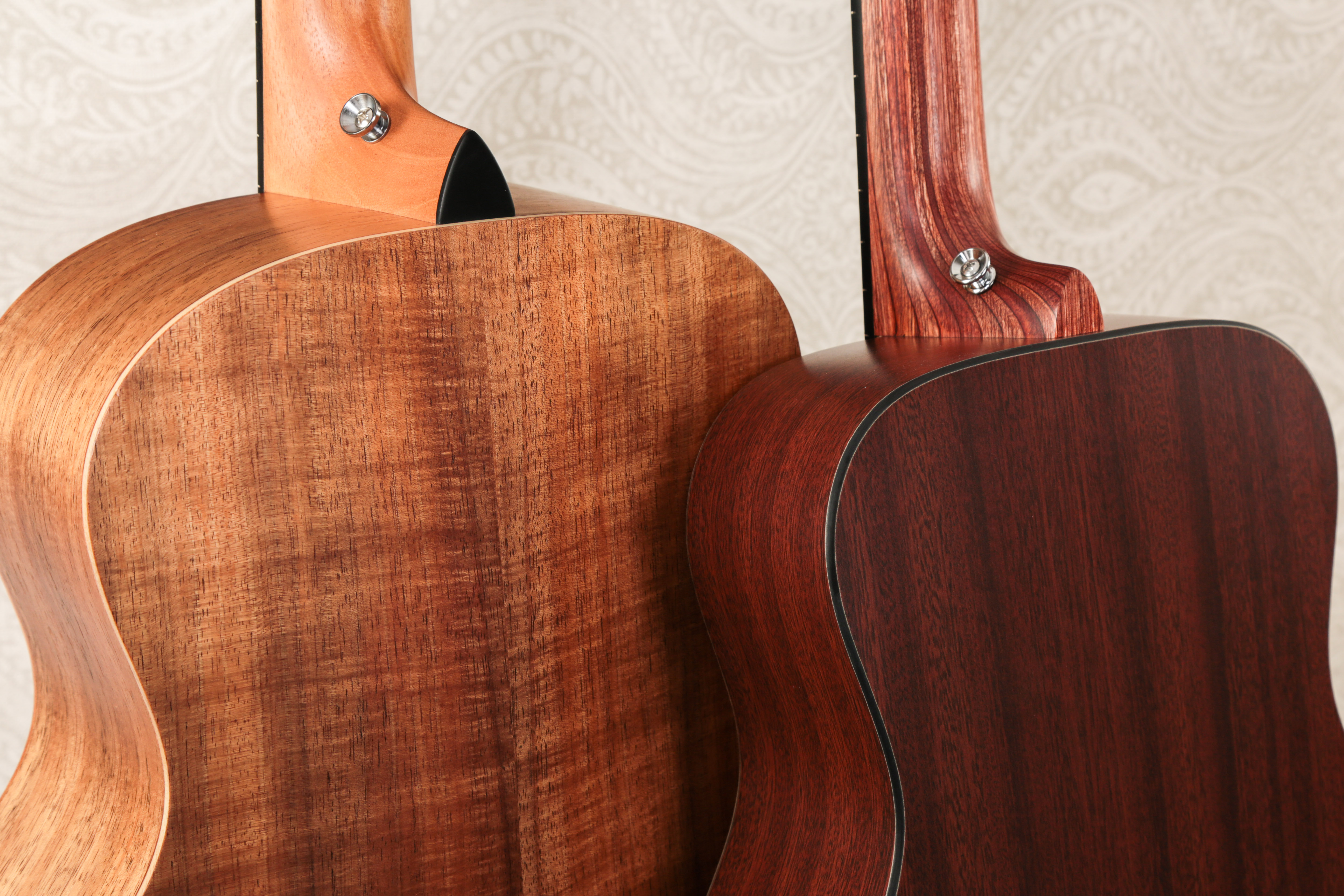For decades, the acoustic guitar was largely synonymous with big-bodied, booming tone. Smaller instruments always had their place, particularly in the folk and blues movements of the early 20th Century. But in recent years, compact acoustics have seen a surge in popularity. As travel has become increasingly accessible, the demands of touring musicians have increased – and manufacturers have responded accordingly.
Ed Sheeran, Taylor Swift and Damon Albarn, to name a few – started using travel acoustic guitars on stage, in the studio, and in music videos. These practical instruments became downright cool, and guitarists across the spectrum got in line for a piece of the action. In this article, we’ll take a look at the two guitars that lead the charge: Taylor’s GS Mini and Martin’s LX1.
The specs in a nutshell:
| Taylor GS Mini | Martin LX1 | |
| Back & Sides | Layered Sapele | HPL Mahogany Veneer |
| Top | Sitka Spruce | Sitka Spruce |
| Neck | Sapele | Rust Birch Laminate |
| Fretboard | Ebony | Richlite |
| Bridge | Ebony | Richlite |
| No. of Frets | 20 | 20 |
| Scale Length | 23.5″ | 23″ |
| Nut Width | 1.69″ (approx) | 1.69″ (approx) |
| Finish | Varnish | Hand-rubbed |
| Electronics | ES-Go (optional) | N/A |
| Case | Padded gigbag | Padded gigbag |
The Taylor GS Mini
The GS Mini has arguably become one of the Taylor’s most popular instruments. The Taylor Guitar brand is often associated with premium, cutting-edge instruments. Imagine that premium brand quality squeezed in both size and price and you have the GS Mini; a beautiful little guitar that bears the Taylor name but comes in at sub-£800*. The most affordable model is usually priced around the £500* mark. So, other than the fact that it’s affordable for a Taylor, what makes the GS Mini so special?
(above) An attractive Koa version of the Taylor GS Mini
Familiar looks & feel
Taylor fans and acoustic guitar aficionados will recognise the company’s instruments from a mile off. The GS Mini fits right into the catalogue, with alluring jumbo-style curves. It’s a scaled-down version of their Grand Symphony model which debuted in 2006 (that’s a Grand Auditorium with a wider waist and broader lower-bout).
By sticking to this design, Taylor ensured that the GS Mini looked the part and provided a comfortable playing experience. Yes, it’s noticeably smaller – but everything is proportionate, almost down to the millimetre. You’ll settle in in no time!
Great tonewood combination
The soundboard is an essential component when it comes to an acoustic guitar’s sound. Taylor knew it’d have to be a solid, dynamic material, so they opted for a classic: Solid Spruce. The resultant balanced sound makes it a perfect jump-off point for pretty much any style.
Next up, Ebony is used for the fretboard and bridge. This adds a pronounced yet smooth quality to the attack of your guitar. It makes fingerpicking sparkle and gives strumming a brilliant edge. To top it off, Taylor have released a number of GS Mini varieties with different tonewoods; Mahogany, Koa and Walnut to name a few.
Incredible full-size sound
This is where the GS Mini guitar comes into its own. It certainly looks great, feels great and the specs are great on paper. But, given its size and price point, the sound it produces is magic.
The Grand Symphony-style body ensures that this guitar really kicks out some volume. Expect booming projection, a rich midrange and crystal-clear treble response. The sound is so unexpectedly good, the GS Mini has won numerous awards and accolades. Not only that, but many guitarists have professed to using it in place of guitars that are 2, 3, and even 4 times the price*.
The GS Mini guitar records well, handles venues of all sizes, and comes with a number of great electronics options. The GS Mini-E model comes pre-fitted with Taylor’s popular Expression 2 system, a fully-fledged pickup/preamp that’s found in many of their high-end instruments. Taylor also specially designed the ES-Go after-market pickup to fit into the GS Mini with ease. It costs around £80*, making it a relatively affordable, easy upgrade!














Responses & Questions